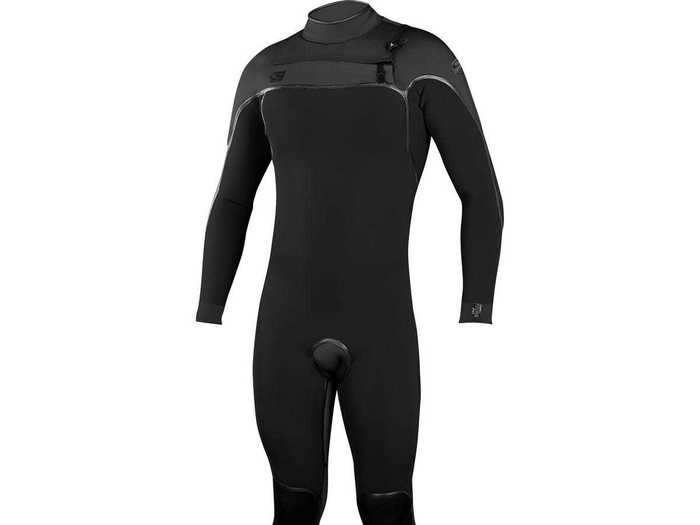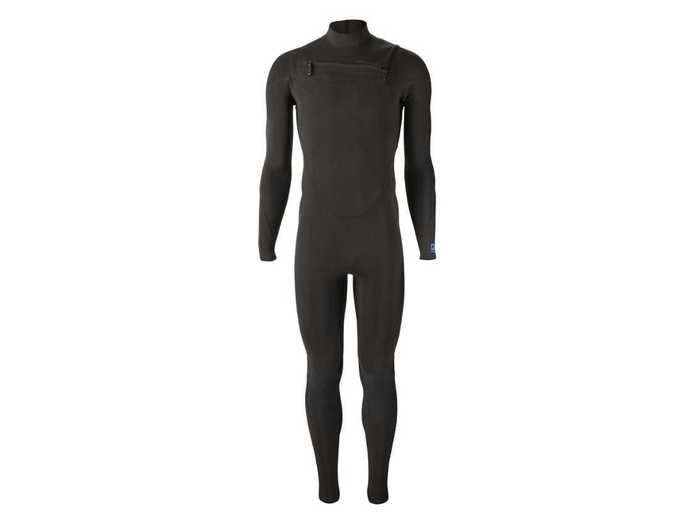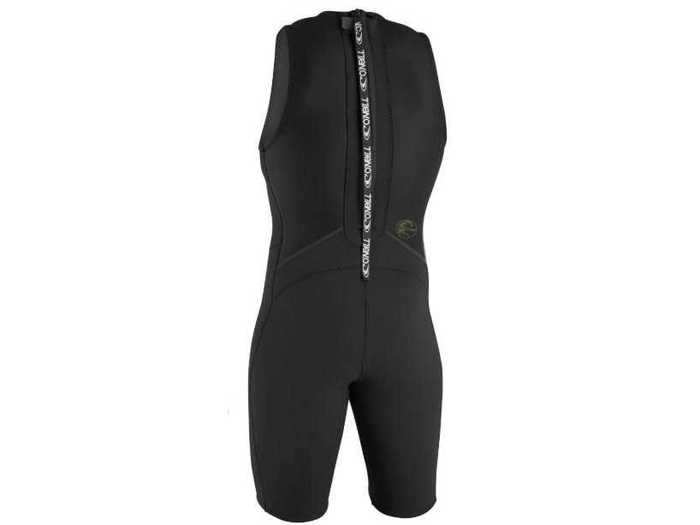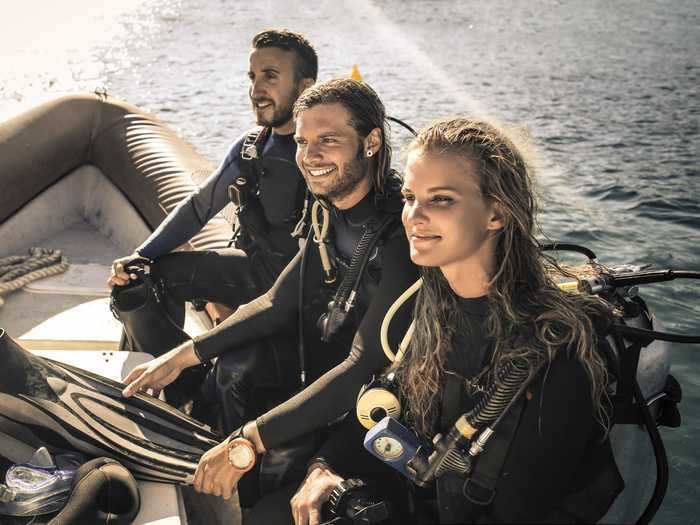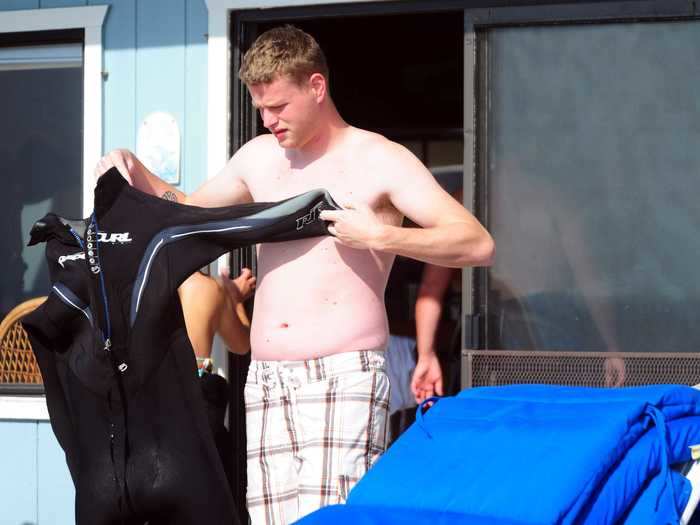- A reliable wetsuit protects you from cold water, ultimately allowing you to surf, swim, dive, or enjoy any other water-based sport far longer than if you didn't have one on.
- Choosing one wetsuit over another varies widely based on what you'll be doing in the water, so we've rounded up the best for a variety of activities based on personal testing and recommendations from surfers, divers, and water sport enthusiasts.
- Our top pick, the O'Neill Psycho Tech Wetsuit Line, is best for most people's wetsuit needs with its water-resistant neoprene material, top-notch stitching, and comfortable fit.
For anyone who doesn't live in places like Hawaii or Central and South America, wearing a wetsuit while surfing is a necessity. Paddling into a wave break with water hovering anywhere from 40 degrees Fahrenheit on up to 60 degrees means braving the incredible cold — but wear the right wetsuit and you'll quickly forget all about the hypothermia-inducing water temp (for the most part).
Surfing isn't the only water sport one might wear a wetsuit for, however. Paddleboarders, kayakers, and divers, among others, also don neoprene getups to keep cold water at bay, but not every wetsuit is a jack-of-all-trades type of suit. What one person might need for kayaking, someone else likely won't need for surfing.
To help anyone shopping for a new suit, I tested a number of options currently available, consulted with diving and surfing enthusiasts, and conducted much research to come up with a guide to the best wetsuits to buy. But first, let's break down how to choose the right suit for your needs.
How to shop for a wetsuitOpen-cell vs. closed-cell wetsuits
Apart from temperature, what you'll be doing in or on the water is a major deciding factor for which wetsuit is best. If you're swimming or surfing, a floaty, hydrodynamic closed-cell or single-piece suit is likely your best bet. These are either chest- or back-zipped and come with different sleeve and leg cuts.
But if you're diving, a closed-cell wetsuit allows too much water flow between it and your skin. You'll find yourself feeling stiff and cold, and stiff and cold are never what you want while diving for long periods of time. An open-cell wetsuit provides suction between the skin and suit that's nearly watertight. While these types of suits are a pain to get in and out of, they keep you much warmer and allow for much greater flexibility underwater.
Editor's note: If you use a little eco-friendly dish soap, getting into an open-cell wetsuit is much easier.
Open-cell suits usually don't have zippers apart from the wrist and leg cuffs but closed cells come in a variety of different zipper configurations. Some manufacturers are starting to develop zipperless models, too, which could eliminate zippers altogether — at least on more expensive suits.
Zipper variation
- Back-zip suit: Back-zip wetsuits are the original design, and almost always cheaper than chest-zip or zipper-less suits. They're fine for swimming in temperate waters on relatively warm days, but I've found that having cool water seep down your back on a chillier day — or in the middle of winter, for that matter — can be miserable.
- Chest-zip suit: Usually more expensive, chest-zip wetsuits tend to keep you warmer thanks to a smaller, well-protected zipper that sits on the front of the suit. This also makes them the most difficult to get in and out of, but, overall, we think they're worth it. They tend to last longer, and some even allow for the neckpiece to be replaced, which is often the first thing to wear and tear on a wetsuit.
- Zipperless: I haven't yet tried out a zipperless wetsuit, though I've been hearing positive buzz about O'Neill's Hyperfreak Comp zipless model. It would be more of a performance suit than most require, and it's hard to say whether the lack of a zipper will, in turn, stretch the suit more or keep us warmer, but we will see how they fare over time and update this guide with our findings.
Wetsuit thickness and temperature rating
Wetsuit thickness is measured in millimeters, and the core is most often thicker than the extremities to keep your body temperature up while allowing for more mobility in the arms and legs. This is why you'll see two — or sometimes three — numbers, listing the core's thickness first (e.g., 3/2, or 4/3/2).
Temperature rating corresponds with thickness, for the most part, but varies some from company to company and material to material, but here's a basic rule of thumb:
- Mid 60s to low 70s: 2 mm
- Low 60s to high 60s: 3/2 mm
- Low 50s to low 60s: 4/3 mm, or 4/3/2 mm
- Low to high 40s: 5/4 mm, or 5/4/3 mm
- Low to mid 40s, high 30s: 6/5 mm or 6/5/4 mm
- Upper 30s and below: While a good 6/5- or 6/5/4-millimeter suit can do you well in the upper 30s, it's tough to stand it any colder. There are 7/6- and 7/6/5-millimeter wetsuits, but they become impedingly stiff at that point. A good 6/5 or 6/5/4 with hood, boots, and gloves will take care of most of us through winter.
Not all sizing is consistent
Size charts vary from company to company, so make sure to have a look at the chart to be sure which one fits you best. Unless you get a custom suit, none are likely to fit you perfectly but you should be able to get close enough.
Stitching and seams
Not all wetsuits are created equal, and while most are made of neoprene — and come from the same factory in Taiwan, despite different brand names — it's the stitching and seams that make all the difference.
- Overlock stitching: This is the most basic stitching, and it will let water flow through your suit like Victoria Falls. Okay, not really, but I save these cheap suits for spring and summer, or when it's not exactly board-short temperature, but a constant flush is actually refreshing.
- Flat stitching: This is probably a little fancier than the stitching they taught you in Home Economics class. By no means is it watertight, but it lies flatter and holds up better than basic overlock stitching.
- Blindstitching: Blindstitched suits have even narrower stitching than flat-stitched ones, and the seams are usually glued, which does a pretty good job of preventing water seepage.
- Sealed, taped, glued: This is a definitive step up, and usually what you'll find with blindstitched suits. Once you get into blindstitching, you start to notice that very little water seeps through your suit, and you stay relatively dry inside. The best of these suits are also sealed and taped both inside and out, but the full combination is where suits start to get above the $500 price tag, which isn't crucial for most. Still, if you plan to be surfing in sub 55-degree Fahrenheit temps, we highly recommend forking over the extra dough.
Here are the best wetsuits you can buy:
Updated on 5/19/2020 by Rick Stella: Updated the introduction to include more on how to shop for a wetsuit and clarified each segment with its own subject header, checked the availability of each selected wetsuit, and updated the prices, formatting, and links throughout.
Read the original article on
Business Insider
The best wetsuit for most scenarios
O'Neill
The
O'Neill Psycho Tech is made with water-resistant neoprene to keep it from retaining water, and its top-notch stitching makes it almost watertight.
O'Neill's Psycho Tech is the kind of cozy, stretchy, almost watertight suit that becomes oh-so-precious to cold-water surfers when winter storms roll through and leaky seams threaten to end surf sessions early.
If there's one company I'd put all my good faith in keeping me from the wrath of hypothermia, it's the late, lauded laureate and godfather of the modern wetsuit, Jack O'Neill.
O'Neill puts a lot of money into research and design, and while the US military doesn't exactly endorse or use any single wetsuit, they've frequently sent personnel out in O'Neill suits. That alone may or may not speak volumes to you, but the US military is not known to be one to skimp on matters of national security.
This wetsuit is flexible, and I've found it to hold up in temperatures considerably lower than their rating. My old Psycho II model from 2009, which saw heavy service through 2010 and has seen service in most of the years since, is still, shockingly, in pretty good shape. The new Psychos are miles ahead, but there aren't enough problems or even one single tear in my suit that warrant tossing mine out just yet.
Cleanline Surf, the Pacific Northwest's coldwater surf aficionados, called the Psycho Tech "the pinnacle of wetsuit technology and performance." The site went on to taut it for being lightweight, warm, durable, and flexible — I don't disagree. Also, the "TechnoButter" neoprene rejects water so well that it stays light even when wet, and it dries much faster than most suits.
Pros: Warm, almost watertight stitching, lightweight, quick-drying
Cons: A little pricey
The best budget wetsuit
Vissla
VISSLA's 7 Seas is economical but doesn't cut any corners to deliver a functional wetsuit at a fair price.
Rip Curl's Dawn Patrol suits for women are equally great and affordable.
I tried VISSLA's 7 Seas model in New York this late spring and was hot in the 3/2-millimeter full suit. That's a good sign. I also caught up with an old friend on Montauk who's in his third season with the same model, which is as much as most people ask of even a luxury suit. That was good enough for me.
It fit me exceptionally well, which is a shock because I'm six feet tall, generally, stay shy of 160 pounds, and almost no company designs standard suits sized for stick-figured string beans like me.
The seams are held together by double blind-stitching and taped three times over, which somewhere around five years ago was unthinkable for a suit under $200. Matter-of-factly, this suit is designed in much the same way one of my nicer suits from about 10 years ago was, only that one cost me about twice as much. The suit's also backed by respective 1-year warranties for both the neoprene and the stitching.
Although the neoprene retains water and gets heavy, the suit is remarkably stretchy — maybe stretchier than Patagonia's Yulex suits — and the wrist gaskets that are located a few inches above the cuff really kept water from getting up my sleeves and slowing my paddling. Further, taking water up the sleeves in fall or winter is shockingly chilling.
I also liked the fuzzy lining, which is akin to Patagonia's, but, again, this suit is less than half the price (at the time of this publishing). While Patagonia's suits are nice, and I love mine, I don't see any need to step up unless you really feel like spending the extra money or you're going to be surfing in exceptionally cold waters where you'll probably want the best technology you can get.
Unfortunately, VISSLA is not manufacturing wetsuits for women yet — the sister company is underway — so we'll have to steer you elsewhere for now. Rip Curl's Dawn Patrol suits are extremely flexible, thoroughly stitched, taped, and glued, and very reasonably priced.
Rip Curl's Dawn Patrol suit has been a bestseller for several years and being blindstitched, glued, and taped for under $200 certainly hasn't hurt its reputation. It also comes in both men's and women's designs, but, I must make a full disclosure: I've never owned one, though I've envied them from close and afar over the years.
Pros: Price tag, sleeve gaskets, stitching and gluing, 1-year warranty
Cons: Neoprene retains water and gets a little heavy
The best non-neoprene wetsuit
Patagonia
There are other non-neoprene suits emerging on the market, but my
Patagonia suits have lasted through a lot, and it will take a lot for another suit to knock them off their throne.
Patagonia's first round of suits got a pass from me because, while the lambswool-lined inside was plush, I noticed that after a few sessions, my friends' nice new suits were really starting to reek. As much as I like the idea of a natural liner to reduce the amount of neoprene used, the smell was enough to rattle my eco-conscious inner hippie and keep me away from these suits.
The next round of suits was made by a biochemical company called Yulex, which makes neoprene from the guayule plant, a hardy shrub native to the Southwestern United States that's used to make rubber that is both renewable and almost chemical-free. It also has a fuzzy synthetic liner that works wonders and makes me feel like I'm warmer. It also makes the inside of the suit feel silky smooth.
Patagonia introduced yet another generation with new patterning intended for "improved fit and increased mobility." Yulex's brand of rubber often had a reputation among wetsuit users as being stiff compared with neoprene, which isn't generally a good thing for water enthusiasts. The company now uses water-based glue, eliminating the volatile organic compounds (VOCs) that were used for decades. The new suit also includes solution-dyed fabrics that reduce water consumption and CO2 emissions by 86% and 96%, respectively.
Of course, as goes with the Patagonia story, everything is Fair Trade Certified, and you'll also get Patagonia's Ironclad Guarantee, so if you're not thrilled with your new suit, you can send it back.
This new round of suits just came out at the time of this writing, and there aren't any customer reviews yet. I'm also still waiting to try the suit, and while I'd still stand by the last generation, I'll put my good faith in Patagonia's favor until I get my chance this fall — we'll update on findings when I do.
What might excite me most about this suit is that, although Patagonia hasn't made the leap to zipperless suits, the corrosion-resistant zipper on this suit is now actually replaceable, so if it wears out before the wetsuit does, you can extend its life a little longer. This is great news, because oftentimes the collar or zipper area is the first thing to wear out on a wetsuit.
Learn more about Patagonia and Yulex's bio-rubber here.
Pros: Long-lasting (as long as if not longer than most neoprene suits), neoprene-free, almost petroleum-free, very warm, so you can often get away with a thinner suit
Cons: Not cheap, maybe a little stiffer than neoprene suits
The best wetsuit for paddlesports
Amazon
If you're tired of hanging up your paddles for the winter,
O'Neill's O'Riginal spring suit is just enough to keep you comfortable as water temperatures reach the 60s and maybe the 50s.
Because our bodies are mostly out of the water when paddling, we tend to work up a sweat beneath a neoprene wetsuit. While any combination of layers can do the trick, I've found that a farmer john-style (sleeveless) wetsuit with flatlock seams works best unless you're dealing with temperatures below 50° F or so, at which point I'd opt for a dry suit. Stohlquist makes a good one for men and women.
Since you're getting such a thorough upper body workout, I'd suggest avoiding sleeves, which apart from causing you to overheat also tend to constrict movement and cause chafing. O'Neill's O'Riginal spring suit is 2 millimeters thick and comes with flatlock seams, and at less than $100 can't really be beaten.
If it's a little cooler, you might want one with full-length legs (the women's model, the Bahia, comes in a 1.5mm), or a 3mm. O'Neill doesn't make the sleeveless suit in a 3mm, but Aqua Lung does, for men and women. Anything above 3mm tends to get a little too hot for paddlesports, at least if you're not getting in the water.
If you want to spend even a little more money — unless you're surfing in one of these suits, keep in mind that quality might not be quite as paramount — Patagonia's Long John (men's) and Long Jane (women's) are $169 and worth it. They're made of the same non-neoprene Yulex rubber as Patagonia's other suits, but flatlock-stitched so that they breathe a little better.
Pros: Flexible, breathable, affordable
Cons: The chest rubber can be overly sticky
How to choose a diving wetsuit and some recommendations
Shutterstock/Merla
A simple, closed-cell suit like a surfing wetsuit works above the surface where you have heat from the sun and little pressure, but when you get below the surface, it can get stiff and cold. An open cell suit will keep you much warmer and more flexible, whether you're freediving or using scuba tanks.
I've never actually owned an open-cell diving suit — I use a surfing suit to dive, which I assure you is less than ideal — so I called on a lifeline: an old friend who spends his workdays and sometimes his nights underwater in the marrow-chilling depths of New Zealand's Marlborough Sounds. If anyone has earned the authority to deem a wetsuit good or bad, we figure it might be a commercial diver, after all.
A commercial diver's input
The array of both open cell and closed cell diving suits in the locker where he works is almost exclusively with Beuchat and Cressi wetsuits, and while many of the members of the dive team do wear closed cell suits to work, they don't last as long — maybe that's intended. Open cell suits are snug, and almost suction-cup your skin, which is extremely efficient for keeping you warm, but makes them very difficult to get on and off.
When we would go spearfishing together — I in my 5/4-millimeter closed-cell surfing wetsuit, he in his 7-millimeter open-cell diving suit — I'd be in and out of my suit in half the time it took him to roll his on and off. But, by the same token, he could still feel his hands and feet after an hour of diving. Meanwhile, my lips would be turning blue.
Bottom line: If you're going to be in even moderately cold water, save yourself the agony of freezing and put up with the nuisance of stretching into a skin-tight open cell suit.
How to shop for a dive suit
If you've never worn or owned a diving wetsuit before, you'll probably want to go to the local dive shop and have the pros sort you out, or at the very least fit you.
When picking out a diving suit, color, or rather pattern, is a consideration that goes beyond aesthetics. If an experience with wildlife is what you're after (even if you're not in search of dinner), then a camouflage suit is probably a good idea, simply because you won't startle as many creatures as quickly as you would with a black suit, or one of any color, really.
Also, note that camouflage is relative: If you're going to be in open water, you'll want a rhapsody in blue, and if you're going to be in kelp, coral, or rocks, you probably want to look for a more greenish-brown pattern.
A few drawbacks
The main downfall of many closed-cell suits is that they are made of or coated with a softer, more delicate rubber-like neoprene skin which, while it keeps you warmer and leaves you agiler in the pressured depths, is highly prone to tearing.
Also, always make sure your wetsuit is wet when you're pulling it on, and follow instructions for care and maintenance like these, from Aqua Lung. Never leave any wetsuit in the sun but especially not a suit with skin material, which will melt and stick to itself, a tragedy not covered by any warranty far as I'm aware.
Aqua Lung, Beuchat, Cressi, and Mares are companies that have all been around since recreational diving has, more or less, and they all have similarly long legacies and popular standing with commercial and recreational divers alike.
Pros: Tighter-fitting, more watertight, keeps you warmer, less constricting
Cons: Can be more expensive, much more delicate, difficult to don and doff
How to take care of your wetsuit
Flicker/Presidio of Monterey
All outdoors equipment requires a little love to survive its life expectancy and, hopefully, beyond. Protect your wetsuit and it protects you — at least from the cold.
Here's what every first-time wetsuit owner should know:
- Wash your suit every time you use it, or at least as frequently as you can stand to. Wetsuits take on everything you put into them, from your sweat, sunscreen, seawater, and yes, urine. While it may not damage your suit, it will surely smell bad. And even though Helen Hunt does it, it's not exactly a good idea to pee in your wetsuit, for obvious reasons. Regardless of whether or not you decide to relieve yourself in your suit, get a wetsuit shampoo, and follow its instructions well. Do NOT use any old soap for this, or you'll be sorry.
- Store your wetsuit in a dry, shaded area with plenty of ventilation. We all know what happens to wet things in confined spaces, but hanging your wetsuit to dry in the sun is surely the quickest way to end its life.
Hang your wetsuit loosely on a thick-framed clothes hanger, a proper wetsuit hanger, or fold it loosely. If you hang a wetsuit on a sharp wire hanger, it will stretch out. If you fold it too tightly, it'll crease. I roll mine up when I travel to avoid creasing.

